Page 507 of 616
5077-2. Steps to take in an emergency
Auris Touring Sports_EE (OM12G12E)
7
When trouble arises
Once
The driver’s door
was opened and
closed with the
engine switch
turned off and
then the engine
switch was put in
ACCESSORY or
IGNITION ON
mode twice with-
out the engine
being started.
Press the
engine
switch
while
depress-
ing the
brake
pedal.
During an engine
starting proce-
dure in the event
that the electronic
key was not func-
tioning properly
(P. 5 5 2 ) , t h e
engine switch was
touched with the
electronic key.
Press the
engine
switch
while
depress-
ing the
brake
pedal
within 10
seconds of
the buzzer
sounding.
Interior
buzzerExterior
buzzerWarning messageDetailsCorrection
procedure
(Flashes)
(Vehicles with a Multid-
rive)
Page 508 of 616
5087-2. Steps to take in an emergency
Auris Touring Sports_EE (OM12G12E)
Once
The driver’s door
was opened and
closed with the
engine switch
turned off and
then the engine
switch was put in
ACCESSORY or
IGNITION ON
mode twice with-
out the engine
being started.
Press the
engine
switch
while
depress-
ing the
clutch
pedal.
During an engine
starting proce-
dure in the event
that the electronic
key was not func-
tioning properly
(P. 5 5 2 ) , t h e
engine switch was
touched with the
electronic key.
Press the
engine
switch
while
depress-
ing the
clutch
pedal
within 10
seconds of
the buzzer
sounding.
Interior
buzzerExterior
buzzerWarning messageDetailsCorrection
procedure
(Flashes)
(Vehicles with manual
transmission)
Page 548 of 616
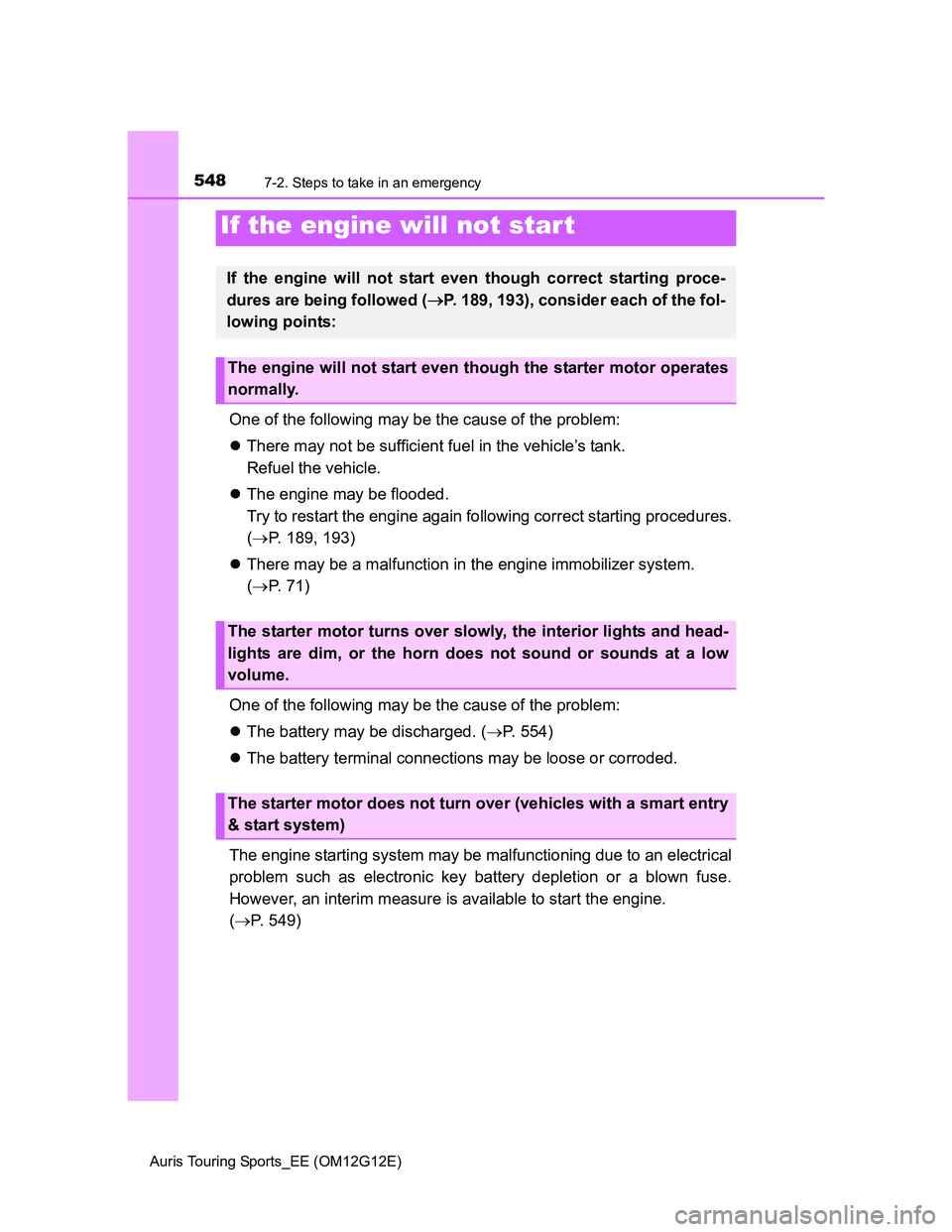
5487-2. Steps to take in an emergency
Auris Touring Sports_EE (OM12G12E)
One of the following may be the cause of the problem:
There may not be sufficient fuel in the vehicle’s tank.
Refuel the vehicle.
The engine may be flooded.
Try to restart the engine again following correct starting procedures.
(P. 189, 193)
There may be a malfunction in the engine immobilizer system.
(P. 71)
One of the following may be the cause of the problem:
The battery may be discharged. (P. 554)
The battery terminal connections may be loose or corroded.
The engine starting system may be malfunctioning due to an electrical
problem such as electronic key battery depletion or a blown fuse.
However, an interim measure is available to start the engine.
(P. 549)
If the engine will not star t
If the engine will not start even though correct starting proce-
dures are being followed (P. 189, 193), consider each of the fol-
lowing points:
The engine will not start even though the starter motor operates
normally.
The starter motor turns over slowly, the interior lights and head-
lights are dim, or the horn does not sound or sounds at a low
volume.
The starter motor does not turn over (vehicles with a smart entry
& start system)
Page 551 of 616
5517-2. Steps to take in an emergency
Auris Touring Sports_EE (OM12G12E)
7
When trouble arises
Use the mechanical key
(P. 111) in order to perform the
following operations:
Locks all the doors
Unlocks all the doors
If the electronic key does not operate properly
(vehicles with a smar t entr y & star t system)
If communication between the electronic key and vehicle is
interrupted (P. 119) or the electronic key cannot be used
because the battery is depleted, the smart entry & start system
and wireless remote control cannot be used. In such cases, the
doors can be opened and the engine can be started by following
the procedure below.
Locking and unlocking the doors
1
2
Page 552 of 616
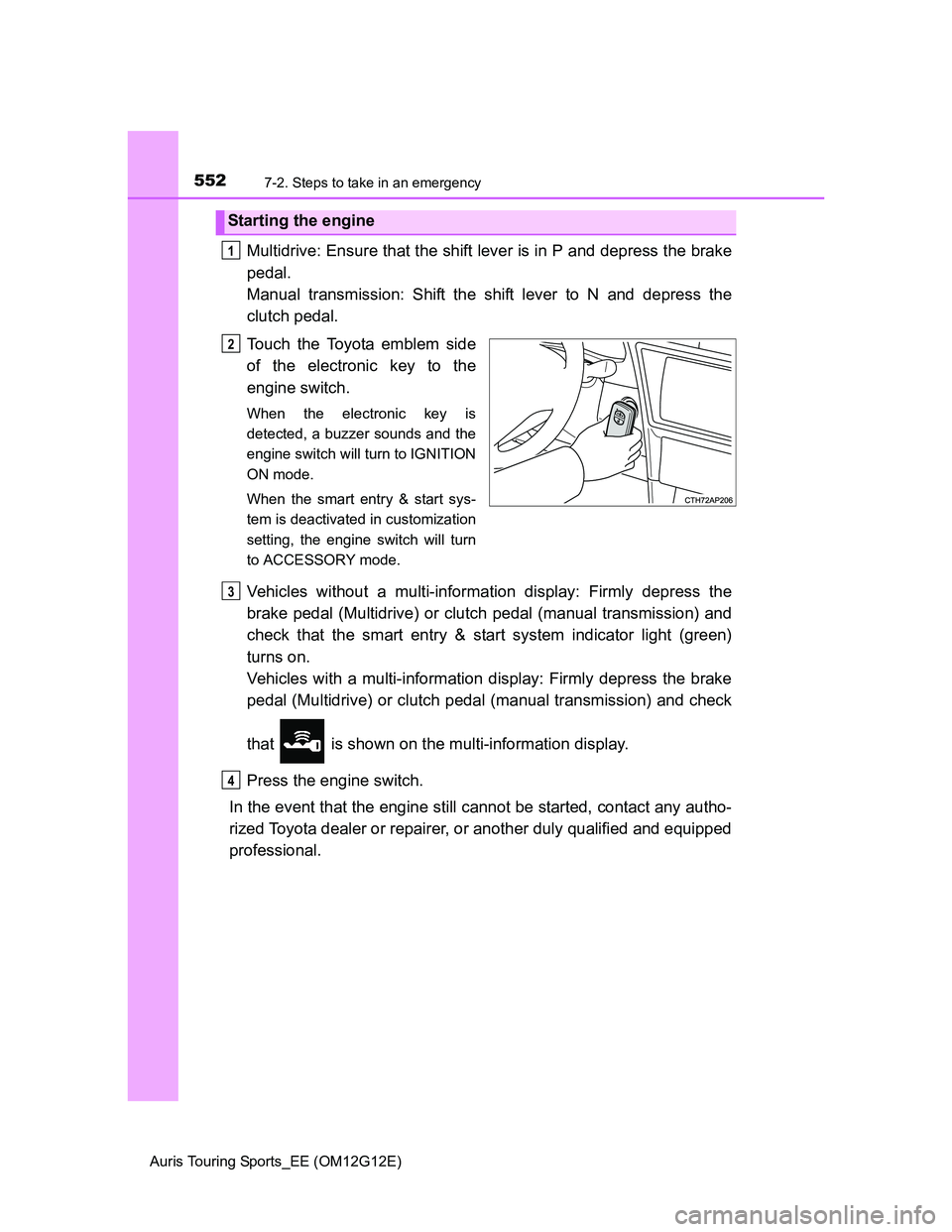
5527-2. Steps to take in an emergency
Auris Touring Sports_EE (OM12G12E)
Multidrive: Ensure that the shift lever is in P and depress the brake
pedal.
Manual transmission: Shift the shift lever to N and depress the
clutch pedal.
Touch the Toyota emblem side
of the electronic key to the
engine switch.
When the electronic key is
detected, a buzzer sounds and the
engine switch will turn to IGNITION
ON mode.
When the smart entry & start sys-
tem is deactivated in customization
setting, the engine switch will turn
to ACCESSORY mode.
Vehicles without a multi-information display: Firmly depress the
brake pedal (Multidrive) or clutch pedal (manual transmission) and
check that the smart entry & start system indicator light (green)
turns on.
Vehicles with a multi-information display: Firmly depress the brake
pedal (Multidrive) or clutch pedal (manual transmission) and check
that is shown on the multi-information display.
Press the engine switch.
In the event that the engine still cannot be started, contact any autho-
rized Toyota dealer or repairer, or another duly qualified and equipped
professional.
Starting the engine
1
2
3
4
Page 553 of 616
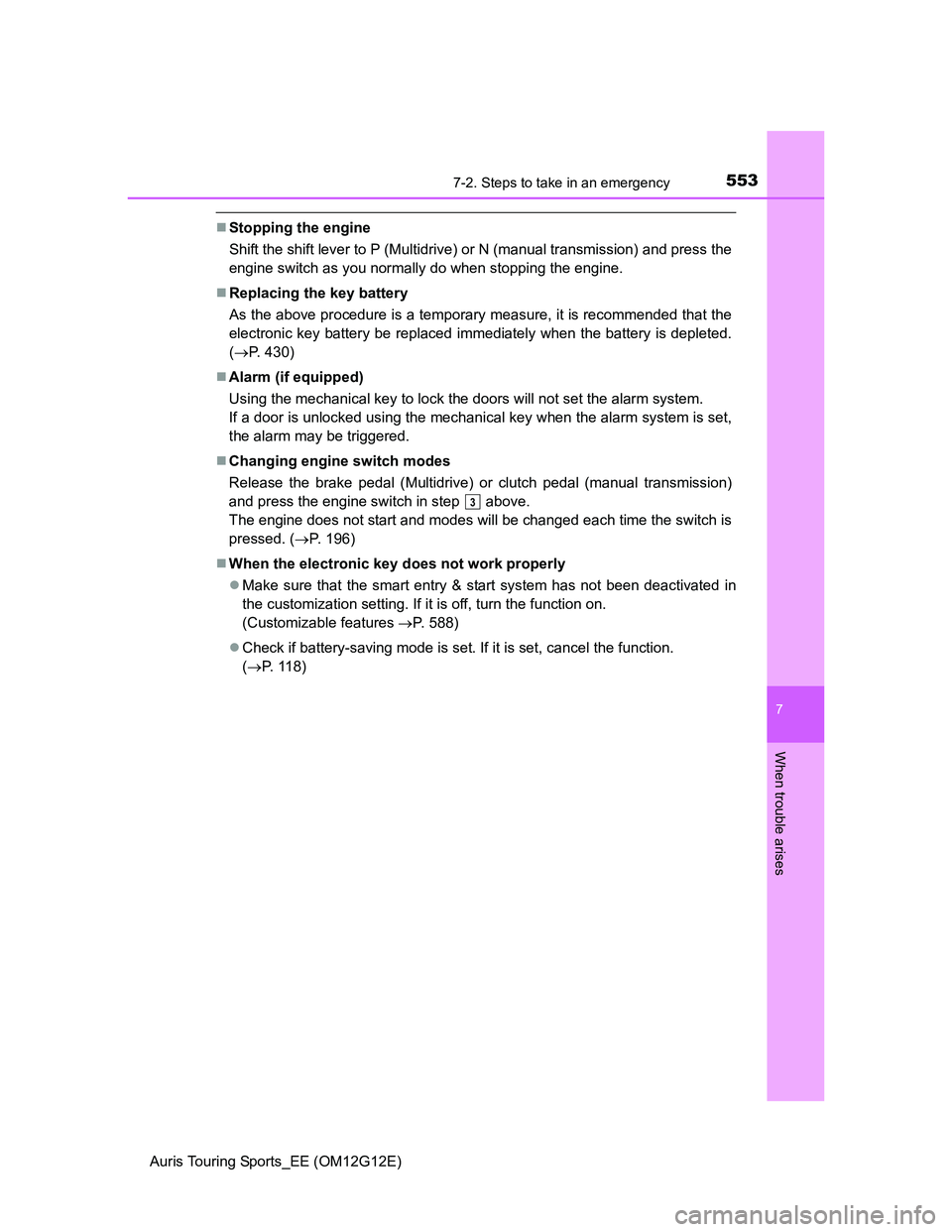
5537-2. Steps to take in an emergency
Auris Touring Sports_EE (OM12G12E)
7
When trouble arises
Stopping the engine
Shift the shift lever to P (Multidrive) or N (manual transmission) and press the
engine switch as you normally do when stopping the engine.
Replacing the key battery
As the above procedure is a temporary measure, it is recommended that the
electronic key battery be replaced immediately when the battery is depleted.
(P. 430)
Alarm (if equipped)
Using the mechanical key to lock the doors will not set the alarm system.
If a door is unlocked using the mechanical key when the alarm system is set,
the alarm may be triggered.
Changing engine switch modes
Release the brake pedal (Multidrive) or clutch pedal (manual transmission)
and press the engine switch in step above.
The engine does not start and modes will be changed each time the switch is
pressed. (P. 196)
When the electronic key does not work properly
Make sure that the smart entry & start system has not been deactivated in
the customization setting. If it is off, turn the function on.
(Customizable features P. 588)
Check if battery-saving mode is set. If it is set, cancel the function.
(P. 118)
3
Page 558 of 616
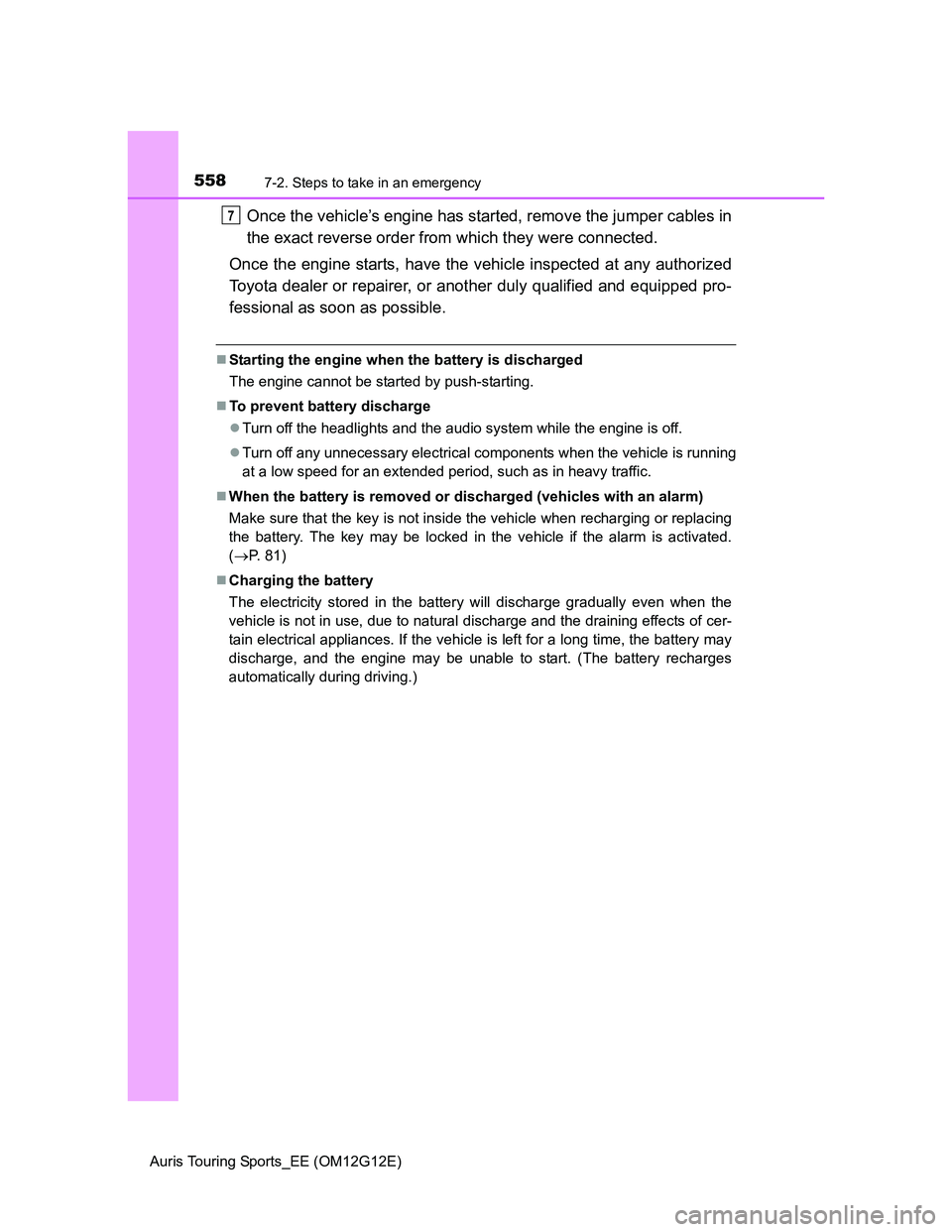
5587-2. Steps to take in an emergency
Auris Touring Sports_EE (OM12G12E)
Once the vehicle’s engine has started, remove the jumper cables in
the exact reverse order from which they were connected.
Once the engine starts, have the vehicle inspected at any authorized
Toyota dealer or repairer, or another duly qualified and equipped pro-
fessional as soon as possible.
Starting the engine when the battery is discharged
The engine cannot be started by push-starting.
To prevent battery discharge
Turn off the headlights and the audio system while the engine is off.
Turn off any unnecessary electrical components when the vehicle is running
at a low speed for an extended period, such as in heavy traffic.
When the battery is removed or discharged (vehicles with an alarm)
Make sure that the key is not inside the vehicle when recharging or replacing
the battery. The key may be locked in the vehicle if the alarm is activated.
(P. 81)
Charging the battery
The electricity stored in the battery will discharge gradually even when the
vehicle is not in use, due to natural discharge and the draining effects of cer-
tain electrical appliances. If the vehicle is left for a long time, the battery may
discharge, and the engine may be unable to start. (The battery recharges
automatically during driving.)
7
Page 559 of 616
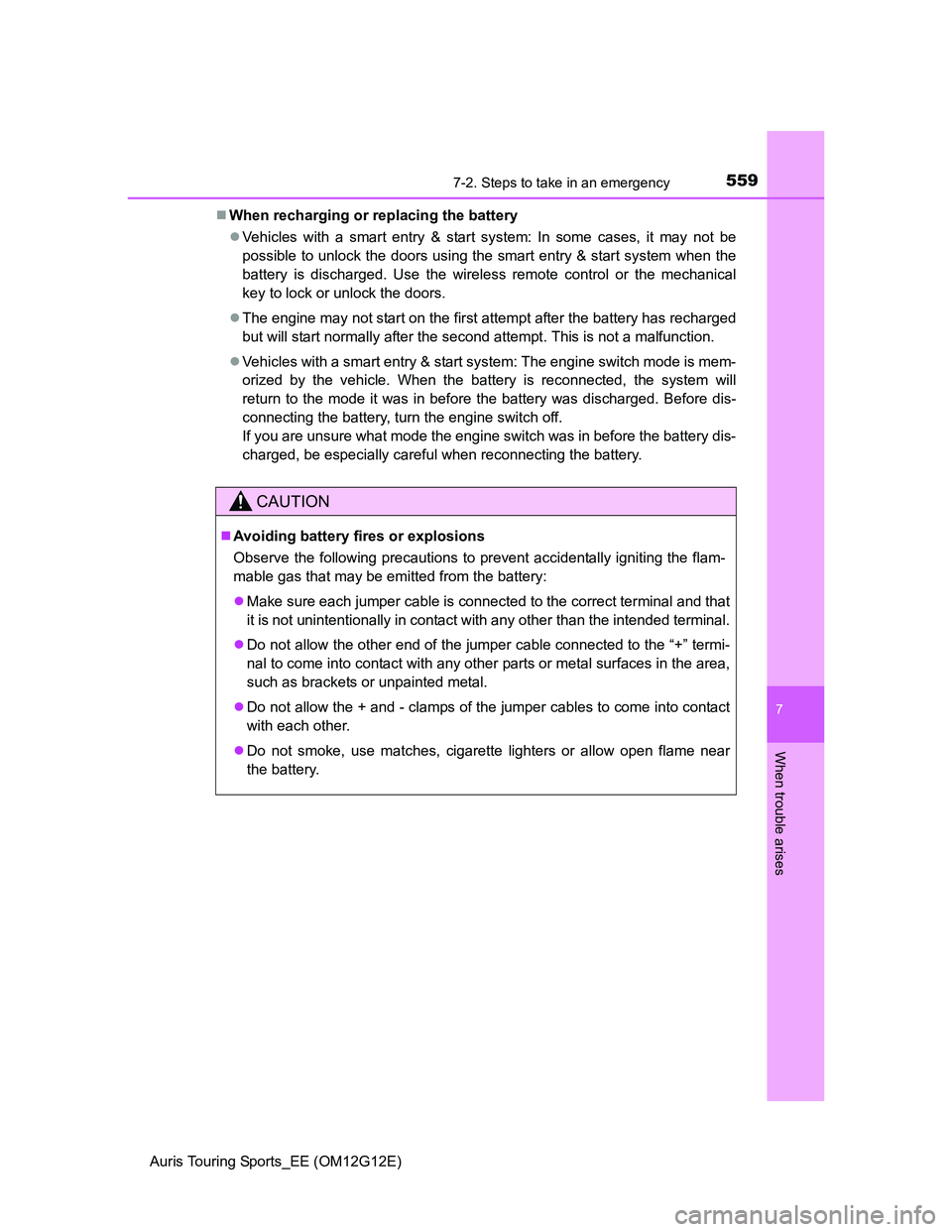
5597-2. Steps to take in an emergency
Auris Touring Sports_EE (OM12G12E)
7
When trouble arises
When recharging or replacing the battery
Vehicles with a smart entry & start system: In some cases, it may not be
possible to unlock the doors using the smart entry & start system when the
battery is discharged. Use the wireless remote control or the mechanical
key to lock or unlock the doors.
The engine may not start on the first attempt after the battery has recharged
but will start normally after the second attempt. This is not a malfunction.
Vehicles with a smart entry & start system: The engine switch mode is mem-
orized by the vehicle. When the battery is reconnected, the system will
return to the mode it was in before the battery was discharged. Before dis-
connecting the battery, turn the engine switch off.
If you are unsure what mode the engine switch was in before the battery dis-
charged, be especially careful when reconnecting the battery.
CAUTION
Avoiding battery fires or explosions
Observe the following precautions to prevent accidentally igniting the flam-
mable gas that may be emitted from the battery:
Make sure each jumper cable is connected to the correct terminal and that
it is not unintentionally in contact with any other than the intended terminal.
Do not allow the other end of the jumper cable connected to the “+” termi-
nal to come into contact with any other parts or metal surfaces in the area,
such as brackets or unpainted metal.
Do not allow the + and - clamps of the jumper cables to come into contact
with each other.
Do not smoke, use matches, cigarette lighters or allow open flame near
the battery.